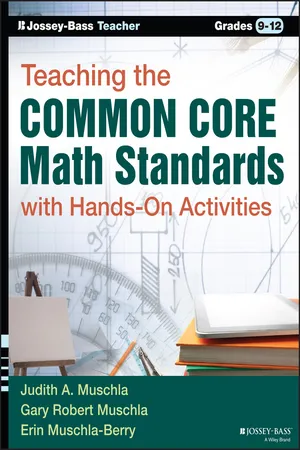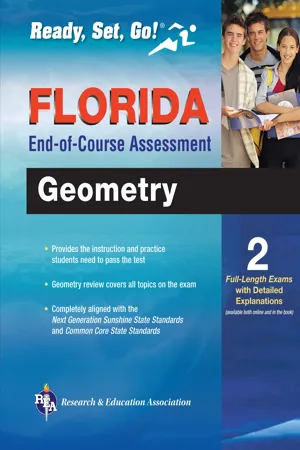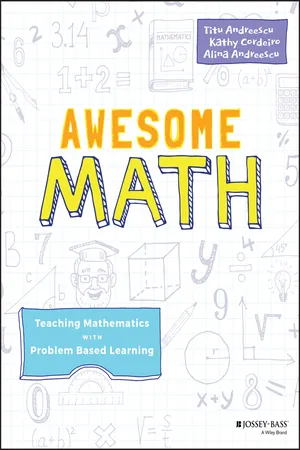Congruent Triangles
Congruent triangles are two or more triangles that have the same size and shape. This means that their corresponding sides and angles are equal. When two triangles are congruent, it means that they can be superimposed on each other, and all their corresponding parts will coincide perfectly. Congruent triangles are important in geometry and are used to prove various geometric theorems.
6 Key excerpts on "Congruent Triangles"
- Gary R. Muschla(Author)
- 2015(Publication Date)
- Jossey-Bass(Publisher)
...However, to prove that two triangles are congruent, it is not necessary to show that all pairs of corresponding sides and all pairs of corresponding angles are congruent. It is sometimes sufficient to show that only three pairs of corresponding parts are congruent. Explain that the reproducible contains four graphs with two triangles on each graph. Corresponding pairs of congruent sides and/or angles are designated with tick marks. Note that the triangles on each graph may or may not be congruent, even though they have three pairs of corresponding parts. Students are to determine which of the pairs of triangles on each graph are congruent. Explain that to find the Congruent Triangles, students should trace the sides or angles of one of the triangles that are marked with tick marks and move their paper so that these sides or angles coincide with corresponding parts of the other triangle on the graph. If the corresponding pairs of sides or angles coincide, then the triangles are congruent. Students should then write the criteria and the transformation or transformations they used. If the corresponding pairs of sides or angles do not coincide, then the triangles are not congruent. Closure Discuss your students' answers. Also discuss the concepts of SSS (all pairs of corresponding sides are congruent), ASA (two pairs of corresponding angles and the included side are congruent), and SAS (two pairs of corresponding sides and the included angle are congruent). Ask students to summarize why these are three criteria for triangle congruence. Answers Transformations may vary. (1) The triangles are congruent by SSS. The sides of the triangle in quadrant II can be rotated 180° about the origin. (2) The triangles are not congruent. SSA is not a criteria for triangle congruence. (3) The triangles are congruent by SAS. Two sides and the included angle of the triangle above the x -axis are moved down 7 units and 3 units to the right. (4) The triangles are congruent by ASA...
- Rebecca Dayton(Author)
- 2013(Publication Date)
- Research & Education Association(Publisher)
...Jackson stated that for a triangle to be obtuse, all three angles must be obtuse. Is this possible? Explain. 2. If Z is a midpoint and Y is a centroid, find the length of. 3. Find the circumcenter of Δ ABC with vertices A (−4, −2), B (0, 2), and C (4, −2). Congruent Triangles Triangles are congruent when all corresponding sides and corresponding angles are congruent. The triangles will be the same shape and the same size. A triangle is defined by a set of six measurements: three sides and three angles. For a pair of triangles, certain groups of three of these measurements can prove their congruency. Triangles are congruent if: SSS (side side side): All three pairs of corresponding sides are equal. SAS (side angle side): Two pairs of corresponding sides and their included angle are equal. ASA (angle side angle): Two pairs of corresponding angles and their included side are equal. AAS (angle angle side): Two pairs of corresponding angles and a pair of non-included sides are equal. HL (hypotenuse and leg of a right triangle): The hypotenuses and one pair of corresponding legs of two right triangles are equal. Example: Determine if the triangles are congruent by SSS, SAS, ASA, AAS, HL, or none of these. Similar Triangles Triangles are similar when all corresponding angles are congruent and when all corresponding sides are in the same ratio. For a pair of triangles, sets of specific measurements can prove their similarity. The following are three theorems that can prove triangles similar: AA (angle angle): Two pairs of corresponding angles are equal. SSS (side side side): All three pairs of corresponding sides are in the same ratio. SAS (side angle side): Two pairs of corresponding sides are in the same ratio and the included angles are equal. Example: Prove Δ ABC ∼ Δ ADE. corresponds to corresponds to The corresponding sides are in the same ratio of. The included angle for both triangles is ∠ A, so ∠ A ≅ ∠ A...
- eBook - ePub
- Mel Friedman(Author)
- 2012(Publication Date)
- Research & Education Association(Publisher)
...CHAPTER 6 Geometry Topics CHAPTER 6 GEOMETRY TOPICS Plane geometry refers to two-dimensional shapes (that is, shapes that can be drawn on a sheet of paper), such as triangles, parallelograms, trapezoids, and circles. Three-dimensional objects (that is, shapes with depth) are the subjects of solid geometry. TRIANGLES A closed three-sided geometric figure is called a triangle. The points of the intersection of the sides of a triangle are called the vertices of the triangle. A side of a triangle is a line segment whose endpoints are the vertices of two angles of the triangle. The perimeter of a triangle is the sum of the measures of the sides of the triangle. An interior angle of a triangle is an angle formed by two sides and includes the third side within its collection of points. The sum of the measures of the interior angles of a triangle is 180°. A scalene triangle has no equal sides. An isosceles triangle has at least two equal sides. The third side is called the base of the triangle, and the base angles (the angles opposite the equal sides) are equal. An equilateral triangle has all three sides equal.. An equilateral triangle is also equiangular, with each angle equaling 60°. An acute triangle has three acute angles (less than 90°). An obtuse triangle has one obtuse angle (greater than 90°). A right triangle has a right angle. The side opposite the right angle in a right triangle is called the hypotenuse of the right triangle. The other two sides are called the legs (or arms) of the right triangle. By the Pythagorean Theorem, the lengths of the three sides of a right triangle are related by the formula c 2 = a 2 + b 2 where c is the hypotenuse and a and b are the other two sides (the legs). The Pythagorean Theorem is discussed in more detail in the next section. An altitude, or height, of a triangle is a line segment from a vertex of the triangle perpendicular to the opposite side...
- Sandra Rush(Author)
- 2013(Publication Date)
- Research & Education Association(Publisher)
...Triangles are one of the most important shapes in geometry. One of the properties of triangles that you probably didn’t think about until now is that they are rigid. That means that once you have three sides attached in a triangle shape, you cannot change it. You cannot make one of the sides longer, and you cannot make any of the angles larger without changing all sides. This is why bridge supports have triangles as their major structure. Try this for yourself: Take two soda straws. Bend one into a four-sided figure and the other into a triangle. Hold together the angle where the ends of each straw meet. Now apply pressure on one of the other sides or angles. The four-sided figure collapses on itself, but the triangle stays rigid. There are several kinds of triangles, but they all have the following things in common: 1. They have three sides and three angles. In fact, that is what the word triangle means: three angles. 2. The largest angle is across from the longest side and the smallest angle is across from the shortest side. 3. The measures of the three angles add up to 180°. So if you know the measures of two angles of a triangle, you can always find the third. This is a consequence of the rigidity of a triangle. 4. Another fact that has to do with a triangle’s rigidity is that, if you know two sides and the angle between them, the other side and the other two angles are fixed. Finding the measures requires a knowledge of trigonometry, which is beyond what the GED ® test covers. Can you see that once we have the lengths of sides DE and DF and we know D, there is only one way to form a triangle (draw EF)? 5. If you know one side and two angles in a triangle, the lengths of the other two sides are predetermined. Can you see above (right) that if we extend the two partial sides, they will meet at a point (let’s call it T) that depends on R and S ? Thus, there is one and only one triangle that can be drawn if you know the two angles and the distance between them...
- eBook - ePub
Awesome Math
Teaching Mathematics with Problem Based Learning
- Titu Andreescu, Kathy Cordeiro, Alina Andreescu(Authors)
- 2019(Publication Date)
- Jossey-Bass(Publisher)
...SECTION III Full Units In this final section, you are provided with full units that range in difficulty from the easiest, “Angles and Triangles” to the hardest, “Nice Numbers.” That said, each unit has problems that are accessible along with problems that will provide a significant challenge for high-level students. The provided examples will bring to life the important concepts and takeaways for the lesson. Be sure to utilize the relate, reflect, and revise process so that the lessons can evolve and grow over time. The chapters have Learning Objectives, Definitions, Vocabulary, Examples, Problems, and Solutions. Some will have interesting facts from history and mathematics when appropriate. All lessons are intended to engage and delight mathematics students of all ages. For further problems and training resources that can be utilized in problem-based learning classrooms, visit http://awesomemath.org ! CHAPTER 9 Angles and Triangles Learning Objectives Students can identify angles and types of triangles. Angles and triangles are fundamental structures in geometry. There are many ways to qualify them, and many important results that follow. Finding relationships between angles is a good exercise for interpreting geometric diagrams and extracting meaningful information. This unit is accessible to middle and high school students. Definitions Right angle. An angle measuring 90°. Perpendicular lines. Two lines that intersect at a 90° angle. Parallel lines. Two lines that run side by side and never cross or intersect. Straight angle. An angle measuring 180°. Supplementary angles. Two angles that added together produce an angle of 180°. Congruent Triangles. Two triangles that are the same size and shape. Similar triangles. Triangles that have at least two angles that are congruent. Angles and Parallel Lines Assume you have a point P in the plane. If you draw a full circle around this point you get 360° rotation...
- Caryl Lorandini(Author)
- 2021(Publication Date)
- Barrons Educational Services(Publisher)
...First, it has to be a right triangle, which means the triangle contains a right angle.DEFINITIONSHypotenuseThe side of a right triangle opposite the right angle; the longest side of a right triangle.EXAMPLE:Leg(s) of a right triangleOne of the two sides that form the right angle of a right triangle; the sides that are not the hypotenuse (see hypotenuse).Pythagorean TheoremThe mathematical relationship stating that, in any right triangle, the sum of the squares of the two legs is equal to the square of the hypotenuse; ifaandbare the lengths of the legs andcis the length of the hypotenuse, thena2+b2=c2.This means that if you take the sides of triangles and make a square on each of the three sides, then the biggest square will have the exact same area as the other two squares put together.There are a few triangles whose sides are Pythagorean triples. A triple is when the sides are all integers. Here are some examples:Also, any multiple of a set of triples will work. It would be a similar triangle that has been dilated.15.2 What Is the Converse of the Pythagorean Theorem?A converse is when you switch the front and the back of a statement.The Pythagorean Theorem states:If a triangle is a right triangle, then the sum of the squares of the legs is equal to the square of the hypotenuse.If we switch it, it becomes:If the sum of the squares of the legs is equal to the square of the hypotenuse, the triangle is a right triangle.This is commonly used to verify if a triangle is a right triangle.EXAMPLE:Are 6, 8, 10 the sides of a right triangle?We would use the converse to test it.If 62+ 82= 102, then we can state the triangle is a right triangle.It is a right triangle.EXAMPLE:Are 11, 13, 21 the sides of a right triangle?We would use the converse to test it.If 112+ 132= 212, then we can state the triangle is a right triangle.It is NOT a right triangle.EXAMPLE 15.2State whether a triangle with the given dimensions is a right triangle.1)9, 12, 152)6, 7, 123)12, 16, 204)9, 10, 14SOLUTIONS1)Yes2)No3)Yes4)No15.3 How Can We Use the Pythagorean Theorem?We have seen how we can use the Pythagorean Theorem to tell whether or not a triangle is a right triangle...





